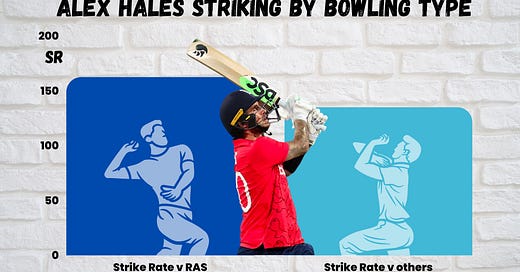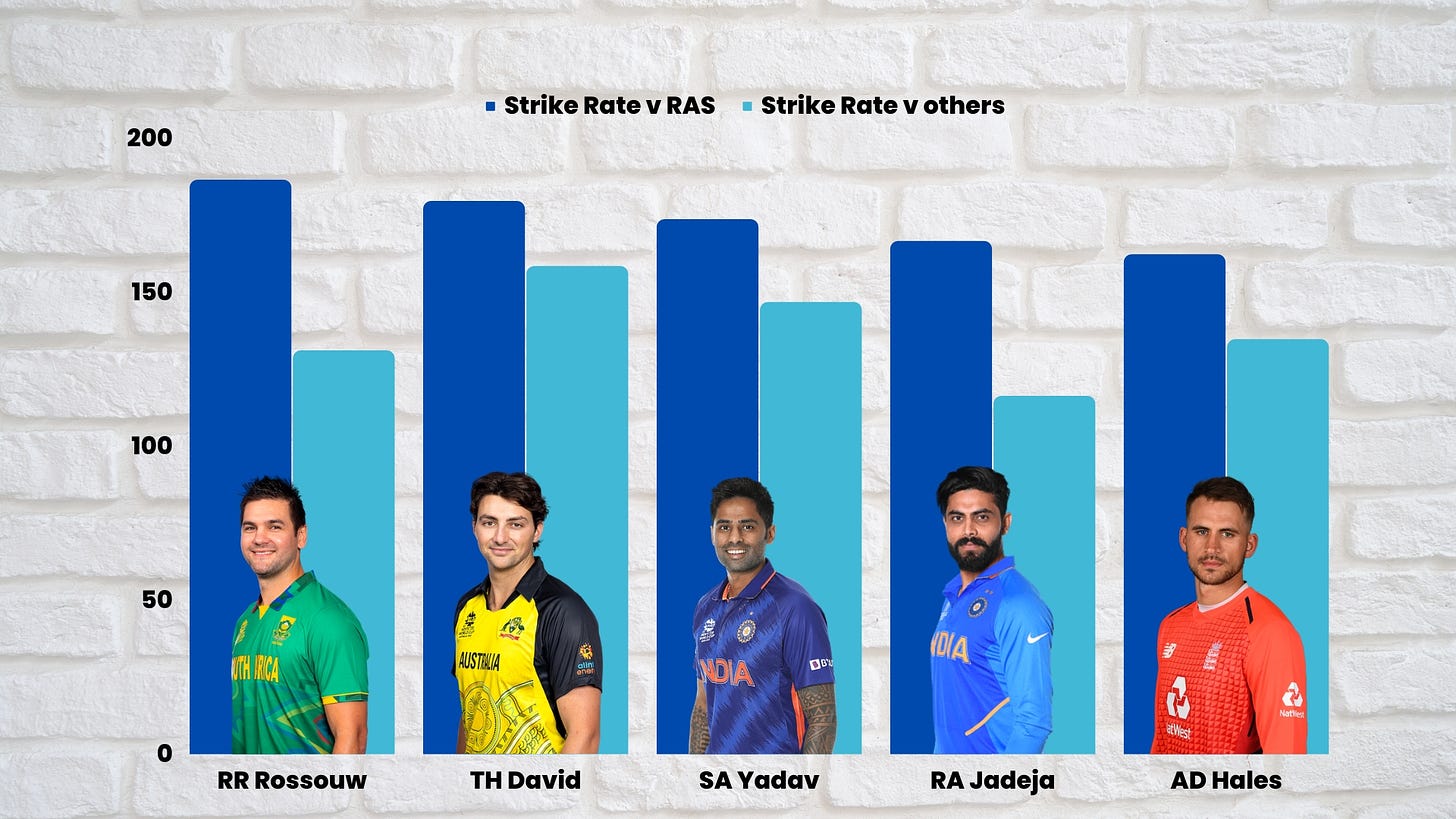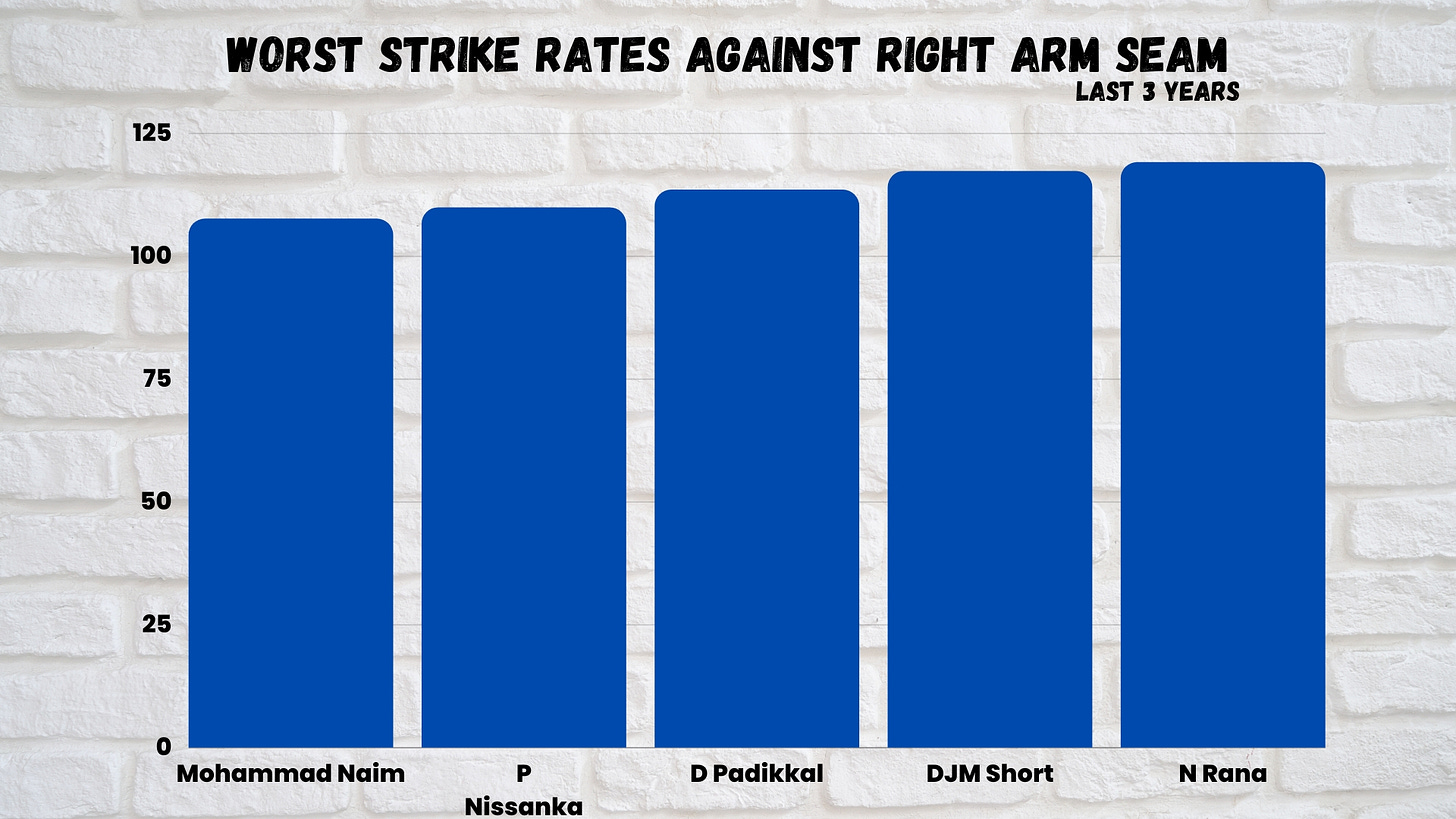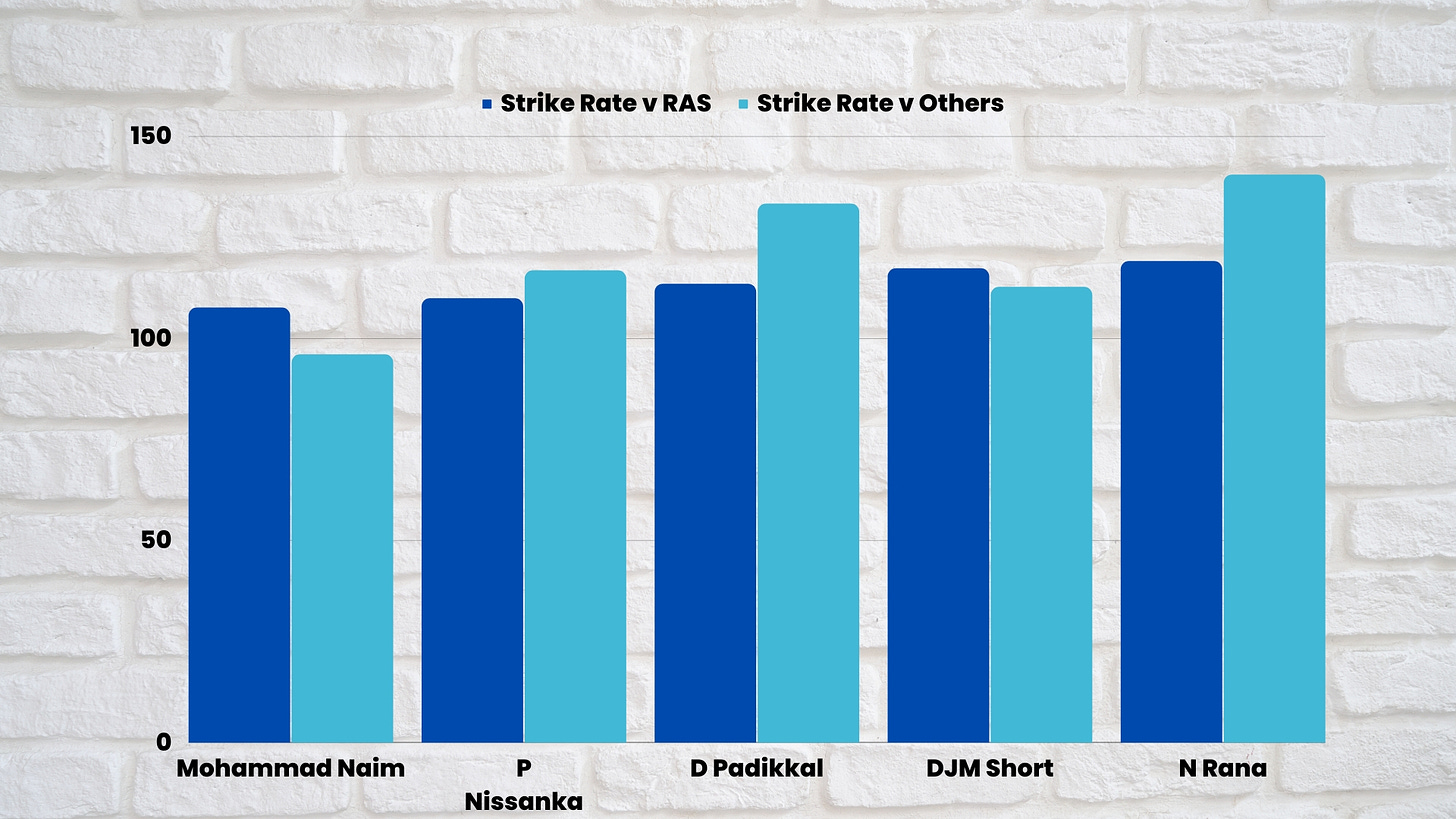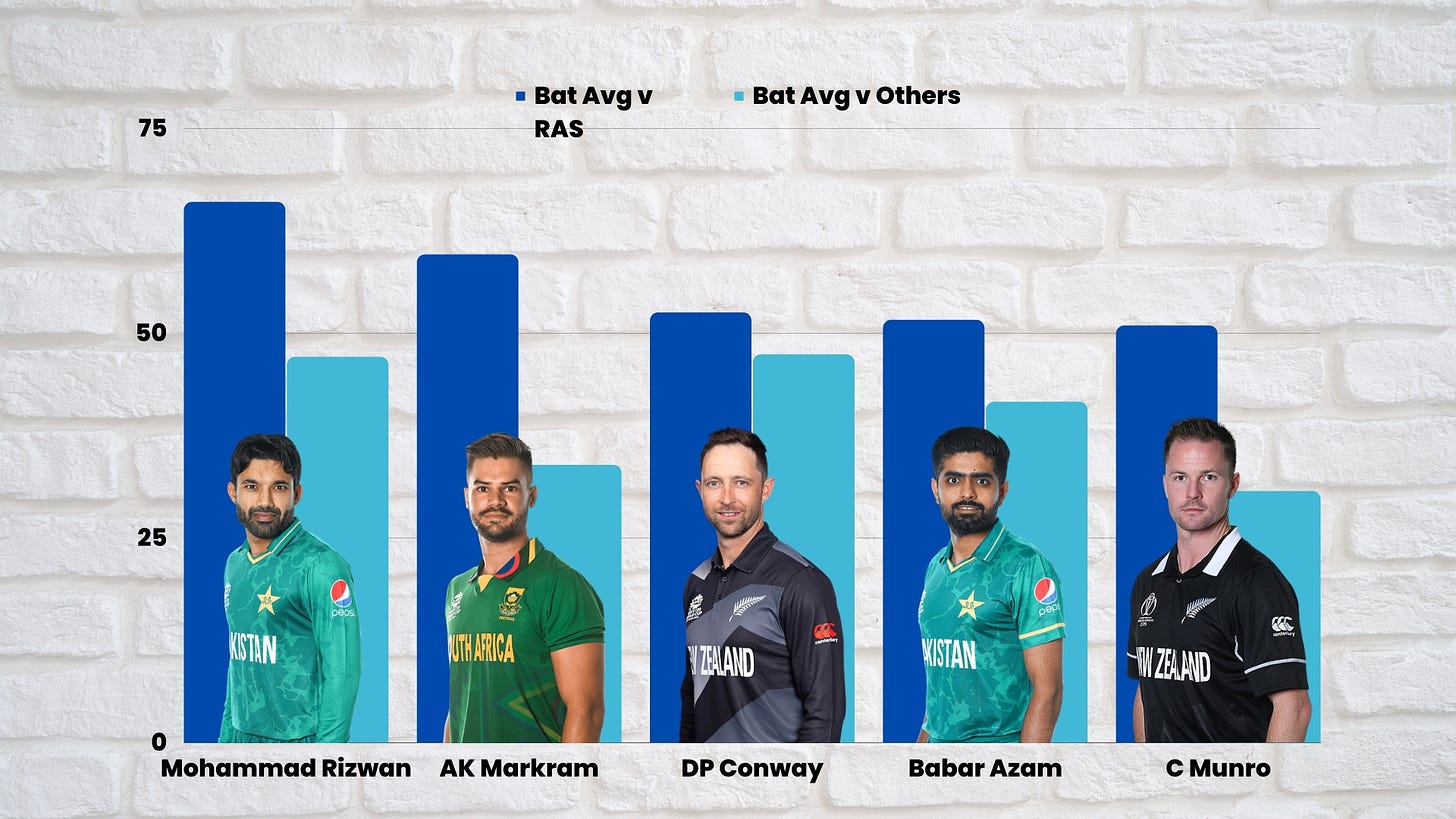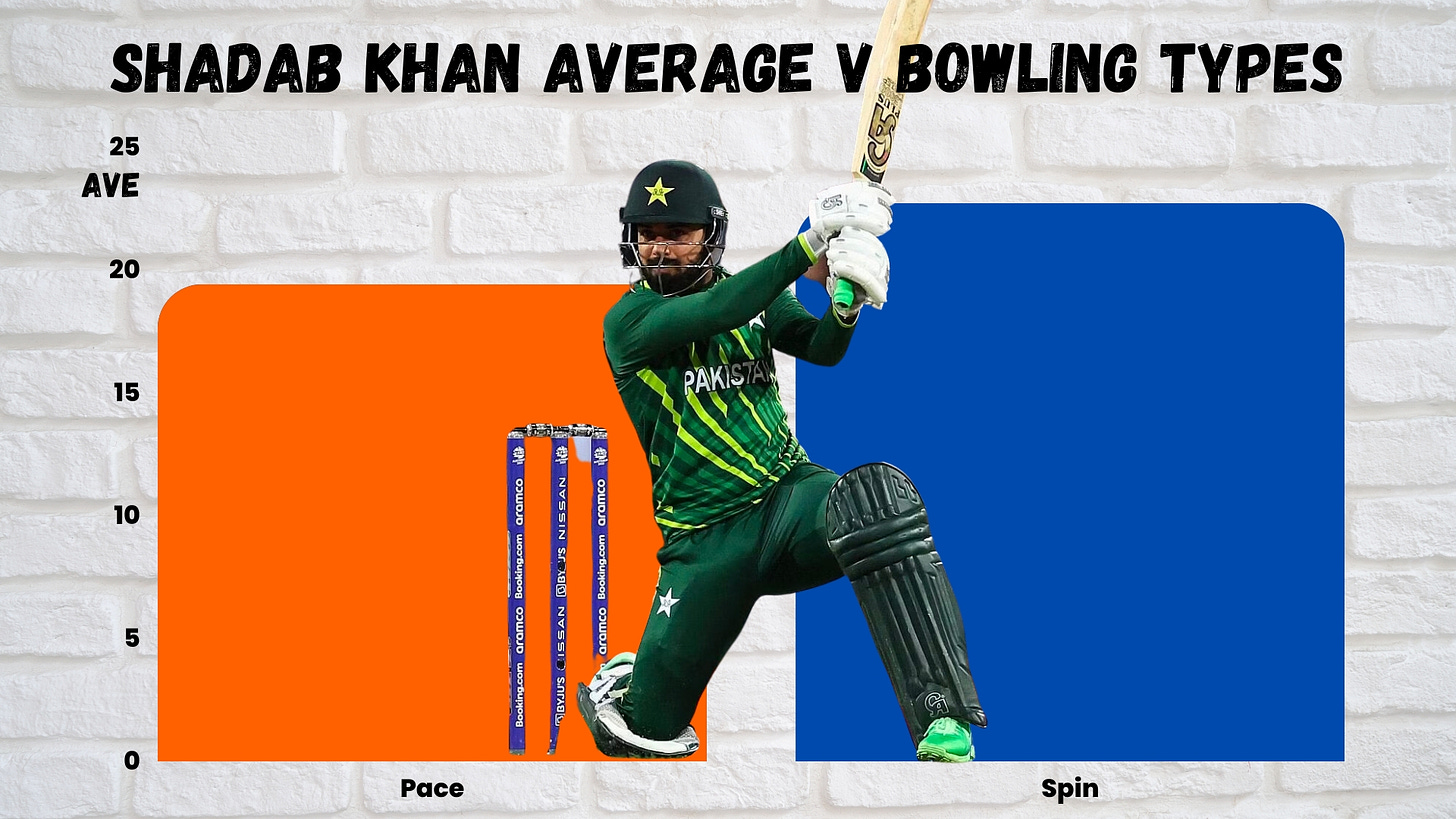
The right arm bashers
Looking at the players who do best (and worst) against cricket's most used bowling type.
I want to talk about Alex Hales.
A few years ago I noticed a trend in English cricket. Their hitting-type batters all absolutely smashed right-arm seam, but usually, they were really weak against spin or left-arm quicks. It was an incredible pattern that happened a lot. I was told by coaches in England cricket that it was because most net bowlers were right-arm quicks, and throw-downs were also from right-arm coaches chucking fast.
But when I started looking into it, there were a lot of batters in the world who could smash right-arm seam, and maybe one other form of bowling, and the majority of their impressive strike rates were from smashing cricket’s normal bowling style.
Alex Hales was the first batter I noticed like this. Last three years he was striking at 162 against right-arm seam, all other bowling is 135.
If that seems like a massive difference, it is. But he is still only fifth on our list. There are so many players around the world that have this, and that is not by accident.
If you close your eyes and imagine a ball dealing deliveries in cricket, chances are it’s right-arm seam. I know this because I got 500 people to do a survey on this for me once. Right arm seam is the sport’s most common form of bowling, regardless of the format. In the last 3 years, right-arm seamers have bowled 49% of all balls, and taken 52% of all wickets.
That is at the top level. Below professional standards, there is even more of it around. You simply cannot be a pro cricketer and not excel against it. This is what you get paid to do. Playing lefties and spinners is secondary to right arm seam at every turn.
And so obviously the best players become exceptional against it. There is simply no other choice. And being that you will probably struggle against one or two types of spin, and left-armers are not for everyone, you need to not just be good against right-arm pace if you want a long career, but usually, be incredible against it.
But we almost never look at who is best against the most common thing in cricket. Well, let us do that. We start by looking at the batters who strike the most against right-arm seamers. Rilee Rossouw sits on top of this list, and he has been incredible in international cricket and franchise leagues since his return. However, DC dropped him after just 5 games. Singapore-born Tim David has established himself as one of the best finishers in the T20 circuit at present. Suryakumar Yadav needs no introduction - he is probably second to only Jos Buttler as far as ability and recent performances are concerned. Ravi Jadeja has had a proper transformation as a death overs pace-hitter in the format, post-COVID. And here is our Alex Hales, ONLY fifth.
All 5 of these batters take less than 4.5 balls per boundary against RAS.
But are they dominant against the other bowling types? We note that each of these 5 batters have a significantly lower strike rate against all other types of bowling than against right arm seam. Ravi Jadeja’s strike rate takes the biggest hit, which is not surprising given his relative lack of ability to hit the spinners out of the park. Alex Hales and Rilee Rossouw slow down in the middle overs once most teams operate with spinners at both ends. Suryakumar continues to produce incredible numbers regardless, though he benefits way more off right arm seam. Tim David maintains a high scoring rate, but he puts lesser value on his wicket otherwise.
Bangladesh opener Mohammad Naim is the slowest batter against right-arm seamers. That is not good at all, especially when you consider he predominantly bats in the powerplay. He somehow also happens to be worse against other bowling types. He is a 23-year-old prospect, and so far T20 cricket has not shown his best side. D’Arcy Short is 32 and has been awful in this format in the past 3 years. Not much to work around with. A few years ago he was smashing right arm seam. So this is shocking. 24-year-old Pathum Nissanka is an anchor and is still in the development stage of his T20 career. But these numbers are very low.
Nitish Rana, primarily a spin-hitter, has had his struggles against short-pitched bowling, but he has significantly better numbers (116 runs @ 58/196) in IPL 2023. Even Devdutt Padikkal has looked at much more ease (111 runs @ 37/142) this season, even though he is batting out of position for the Royals. It will be interesting to see if it is a one-off, or if they can sustain it for a longer time period. When we factor in their performances against other bowling types, they suddenly do not look as bad anymore.
Even though T20 is evolving fast, wicket preservation continues to be an important aspect, particularly for top-order batters. You cannot be an elite anchor-type batter if you do not have high balls per dismissal. And we need at least one of these in an ideal T20 batting lineup to tackle quality bowling upfront and handle collapses.
No one in the world will be surprised to see Mohammad Rizwan at the top of this list. He also does it at a decent clip (137.3 SR). Aiden Markram is the only batter to average over 50 and strike at over 150 against this bowling type. He is one of the finest batters against high-pace, back-of-length bowling. Devon Conway is a long-stay opener, who usually has a high strike rate, but not against right arm seam (125.8) as compared to others on this list. Babar Azam has a very similar strike rate to Rizwan’s, which makes sense considering they face most of the deliveries for Pakistan in T20 cricket. After playing his last T20I in January 2020, Colin Munro has been pretty good in franchise T20 cricket across the globe. He strikes at 144 vs RAS, which is solid.
While there is a drop in average for each of these batters, Markam and Munro’s averages have the biggest dip in this group. Munro’s strike rate remains pretty much the same though. Markram’s strike rate also takes a massive hit (132.2). And this is when he has not even opened the batting in the past 3 years.
Markram is such a fascinating player. He has every skill you would want, but something has never felt quite right about him. And you look at this, and you wonder if this is one of his major - if not hidden flaws. Remember Markram is a middle-order player, one who often smashes the ball at the end, but does struggle to rotate strike or attack the spinners. Would he be better up to the top, facing more quicks, or at the end, I find it interesting that he is so constantly used in the middle order. I have long said he feels like an opener, but maybe he prefers knocking it around before he smashes the ball. Certainly, a set Markram at the death is a problem for any right-arm seamer.
Conway starts scoring much faster against other bowling types, even if that comes at the cost of lower balls per dismissal. Babar and Rizwan have a much lower average and strike rate - something they have faced a lot of criticism for in recent times. Perhaps they should try optimizing their scoring rates against right-arm seam, since they are technically sound against that bowling type, to make up for their slow batting otherwise?
We now look at the lowest averages. There seems to be a pattern here. Most of these batters are lower-order hitters who cannot afford to put much value on their wicket. Haider Ali is an exception, he is still a young batter with a lot of work to be done on his overall game. If you are not a hitter or a new better like Haider, you really shouldn’t be on this list.
But from this, we have some clear roles. There are guys who smash spin and guys who bat at the death because they can only play RAS. T20 is going in the direction where you need phase specialists to maximize your output with both bat and ball. And teams are learning it the hard way.
To put it simply, hitting more boundaries is the best way to optimize 120 balls. Balls per boundary (BpB) is an important metric for gauging the quality of a T20 batter. We look at some players with an exceptional BpB record. Only 6 batters hit a boundary every 4 balls or less against right-arm seamers - Rossouw, SKY, Shaw, Lewis, Hales & Russell. 4 of these also have the highest strike rates vs this bowling type.
The correlation between BpB and the scoring rate is pretty obvious. But there are quite a few batters in this cluster who maintain a good strike rate against right-arm seam, despite taking over 5 balls per boundary.
I want to go back to one player. A few years ago I did a similar piece to this, and the thing I found was that almost no players score quicker against spin than seam. It’s a massive inefficiency within the game. And often the players who did - Kamran Akmal was one - don’t end up in the middle overs enough.
And a lot of this is how confusing this all is because of how numbers look in T20. Here is Shadab Khan, who you saw had one of the worst averages against right-arm pace. When you factor in all his batting in the last three years against pace and spin, his average against pace isn’t that much lower.
But when you look at strike rate, you will see that Shadab’s actually still scoring quicker against the pace bowlers. So you might think that he might as well stay at the end. But this shows his econ against spin - which is largely bowled at him in the middle overs. And his strike rate against pace which he smashes at the death. He has only ever faced 22 balls of spin at the death. When he faces spin and pace in the middle, he scores quicker against spin. Which is huge.
Let’s look at how big his swing is. He scores a run an over quicker than others against spin in the middle overs of T20. Where he actually scores just below average vs quicks. So Shadab Khan should bat in the middle. I show this to show you a couple of things. One is how hard it is to even prove someone is a spin specialist - even when my eyes do. But also that right-arm seamers bowl a lot in the powerplay and death, and so the guys who score off them tend to smash them more. Which does account for some of the differentials we see.
Of course, that doesn’t change the obvious that players see them a lot and feel the most comfortable against them as a whole. It shows you how talented you have to be as a right-arm seamer to survive, so many of them are doing incredible work. And at the time of writing this, Shami has dismantled the Capitals’ top order. So their value is even more in an increasingly batter-dominated format.
One final thought about all this is that what myself, Shayan and Ritwik have done with this analysis is pretty rare. And even teams are just getting down to this granular detail over the last few years. That means that we are looking at the first generation of players coming through under the age of 24 who have grown up knowing their stats against each type of bowling.
If you look back at before there was limited overs cricket, you only needed to survive your worst kind of match-up. Now you need to be able to score off it too. In the future, will all this information build more specialists or rounded hitters? Or perhaps, more of both.
But one thing won’t change in cricket. If you are good against right-arm seam as a batter, there is probably going to be a career for you somewhere.


